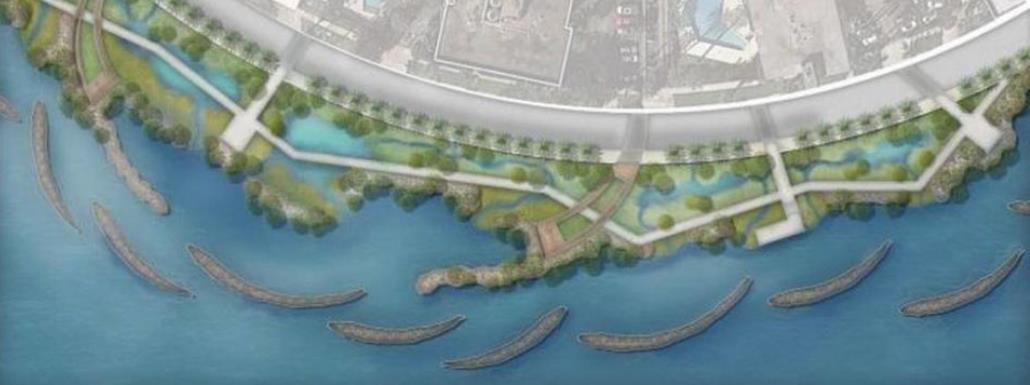A New Plan To Protect Miami’s Coast From Storms Is Underway
A new package of protective measures for Miami-Dade’s storm-prone coast — and billions of federal dollars to pay for them — is again on the table after the county agreed to join the Corps. of United States to advance a new coastal defense study Army engineers.
The county tried to do so in 2018, but after three years, Miami-Dade rejected the nearly $5 billion plan the federal government had drawn up to protect the coast from storm surges, largely over concerns that the high walls along of the coast that the Corps of Engineers built could not be built suspected to be ugly and undesirable by the residents.
This time, the Corps of Engineers and the county worked together and held several public meetings to hear from Miami-Dadeans. The result, announced Friday, was a set of ideas that the Corps could afford to build and the county could support.
On the table are many of the same ideas as the first study: raising thousands of homes along the coast, improving flood defenses for businesses and large facilities like hospitals and fire stations, and planting mangroves and other nature-focused solutions.
“It’s critical to our future,” said Mayor Daniella Levine Cava. “It prepares us for the opportunity we know is coming.”
“It will be a combination of physical, structural barriers and natural solutions,” she said. “I think it will be a very innovative and modern approach. I’m excited to see how it develops.”
This decision is the prelude to another four-year, $7 million study that will end with a concrete plan to secure the Miami-Dade waterfront. A draft plan, open for comment, could be ready in about two years, but the actual work will take longer. At top speed, none of the ideas contained in the plan could be fully designed or built for more than a decade.
“This renewed commitment underscores our commitment to improving storm surge risk reduction and resilience in Miami-Dade,” said Col. Brian Hallberg, USACE Norfolk District Commander, in a statement. “We believe that by working with the community, we can develop projects that not only protect life and property, but also help preserve Miami-Dade’s valuable ecosystems.”
Retaining Walls and Barriers
The most significant change between the first version of this study, also called Back Bay, and the latest version is that it focuses on nature-based solutions (such as coral reefs and mangrove plantations), on the height and protection of individual buildings, and moving distance to larger structural ones protective devices such as walls.
But just because these ideas have been dropped for now doesn’t mean they can’t be picked up later through grants or additional study.
The move from walling to raising homes and businesses is causing the county to accept a lower level of protection than was initially offered by the Corps of Engineers.
But in the meantime, current residents of Miami-Dade have spoken out: no high walls along the waterfront, better more plants instead. Murley believes the answer is a more incremental approach, solutions that can be gradually stacked over time, then growing stronger as the threat increases.
And it’s not just about Miami. Florida residents across the state are faced with the possibility of billions of dollars in federal funding to shield shorelines, mostly with walls, and continue to say “no.”
In Collier County, which was recently hit by Hurricane Ian, hundreds of residents gathered in public meetings to protest the Corps of Engineers’ original idea to build tidal locks and other structures. They wanted nature-based solutions like mangroves and artificial coral reefs.
“People said, ‘I’d rather flood than see that lock every day,’” said Rachel Rhode, director of the Environmental Defense Fund’s Climate Resilient Coasts and Watersheds Initiative.
She has looked at all of the Corps of Engineers’ coastal surveys and said the pattern is the same everywhere, including a new coastal survey in St. Augustine that has just begun.
But the calculations the Corps of Engineers has relied on for years to determine the “best” solution take into account things like protecting property values and don’t consider the habitat or water quality benefits that result from using mangroves instead of a dyke or even a dyke gives mangroves along with a dyke.
“The Corps of Engineers have such a hard time quantifying the benefits of natural elements, which is why they’ve had such a hard time integrating them,” Rhode said. “You can easily quantify a wall or a fence – and have been for decades – it’s very static, but it’s much more difficult to quantify the benefits of nature-based elements.”
That’s changing in Miami as local scientists rush to study the protective effects of coral reefs and mangroves against steel and concrete, and the Corps has launched its process to begin testing other “integrated benefits.”
Rhode said that’s what makes the Miami-Dade study so important.
“Everyone knows Miami, it’s the place that’s on the front lines,” he said. “I think Miami will not only set a precedent for other cities, but also for the Corps of Engineers and their approach to these studies.”
Source: Nation World News



